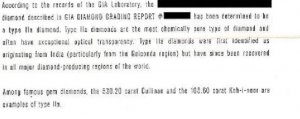- Joined
- Feb 26, 2003
- Messages
- 379
The short version or a definition is?
Blue White diamond is a blue fluorescent diamond that only has a one grade shift in color when being color graded under a grading light with and without a Lexan filter.
Next question - is D to F and acceptable range before or after the shift?
And would a low D that shifted to a high F still be Blue White?
I am concerned Michael that if people make such claims that there should be a clear and concise definition.
(I would also like to find one for color grading light sorurces - I do not accept the ancient opinions of single people in days with very different knowledge and lighting sources.) Garry Holloway
I see Wade and Bruton not as single people with ancient opinions. Instead, I see them as the diamond experts that they were in their respective eras providing us windows through their writing into diamond industry knowledge, grading and valuation.
As explained by both, the true blue white or Jager stone is a blue fluorescing diamond that still appears white in lighting which does not stimulate fluorescence, whereas the "false white" shows tints of color in the same lighting. That is both a concise definition and the way to test. When the diamond is not fluorescing is it white or tinted?
Since you asked, I would say to be on the safe side take GIA''s teaching that a diamond begins to "draw color" at G.
If a VSB D color diamond stays in the D-F range that GIA calls colorless, it is safe to say it qualifies as a Jager.
If, as the more common VSB diamonds do, the color absent fluorescent stimulation drops three or more grades, the stone clearly does not qualify as a Jager. At some point (you decide) it is the "false color" diamond well known in the diamond trade going back before the turn of the 20th century.
Antoinette''s 3.02 carat cushion is a textbook example of what both diamond experts in Wade''s time and Bruton''s time called Jager or the true "blue-white".
Michael D Cowing
Blue White diamond is a blue fluorescent diamond that only has a one grade shift in color when being color graded under a grading light with and without a Lexan filter.
Next question - is D to F and acceptable range before or after the shift?
And would a low D that shifted to a high F still be Blue White?
I am concerned Michael that if people make such claims that there should be a clear and concise definition.
(I would also like to find one for color grading light sorurces - I do not accept the ancient opinions of single people in days with very different knowledge and lighting sources.) Garry Holloway
I see Wade and Bruton not as single people with ancient opinions. Instead, I see them as the diamond experts that they were in their respective eras providing us windows through their writing into diamond industry knowledge, grading and valuation.
As explained by both, the true blue white or Jager stone is a blue fluorescing diamond that still appears white in lighting which does not stimulate fluorescence, whereas the "false white" shows tints of color in the same lighting. That is both a concise definition and the way to test. When the diamond is not fluorescing is it white or tinted?
Since you asked, I would say to be on the safe side take GIA''s teaching that a diamond begins to "draw color" at G.
If a VSB D color diamond stays in the D-F range that GIA calls colorless, it is safe to say it qualifies as a Jager.
If, as the more common VSB diamonds do, the color absent fluorescent stimulation drops three or more grades, the stone clearly does not qualify as a Jager. At some point (you decide) it is the "false color" diamond well known in the diamond trade going back before the turn of the 20th century.
Antoinette''s 3.02 carat cushion is a textbook example of what both diamond experts in Wade''s time and Bruton''s time called Jager or the true "blue-white".
Michael D Cowing






300x240.png)